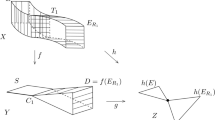Abstract
We study certain families of K3 surfaces in Fano 3-folds that contain curves.



Similar content being viewed by others
References
Batyrev, V.V.: Dual polyhedra and mirror symmetry for Calabi–Yau hypersurfaces in toric varieties. J. Algebr. Geom. 3, 493–535 (1994)
Batyrev, V.V.: Toroidal Fano 3-folds. Math. USSR, Izv. 19, 13–25 (1982)
Eisenbud, D., Lange, H., Martens, G., Schreyer, F.-O.: The Clifford dimension of a projective curve. Compos. Math. 72, 173–204 (1989)
Galkin, S.S.: Small toric degenerations of Fano 3-folds. Preprint (2007)
Kobayashi, M., Mase, M.: Isomorphism among families of weighted K3 hypersurfaces. Tokyo J. Math. 35, 461–467 (2012)
Martens, G.: Über den Clifford-index algebraischer Kurven. J. Reine Angew. Math. 336, 83–90 (1982)
Martens, G.: On curves on K3 surfaces. In: Ballico, E., Ciliberto, C. (eds.) Algebraic Curves and Projective Geometry. Lecture Notes in Mathematics, vol. 1389, pp. 174–182. Springer, Berlin (1989)
Mase, M.: Families of K3 surfaces in smooth Fano 3-folds. Comment. Math. Univ. St. Pauli 66, 103–114 (2012)
Moĭšezon, B.G.: Algebraic homology classes on algebraic varieties. Math. USSR, Izv. 1, 209–251 (1967)
Mori, S., Mukai, S.: Classification of Fano 3-folds with B 2≥2. Manuscr. Math. 36, 147–162 (1981)
Mori, S., Mukai, S.: On Fano 3-folds with B 2≥2. In: Iitaka, S. (ed.) Algebraic Varieties and Analytic Varieties. Adv. Stud. Pure Math., vol. 1, pp. 101–129 (1983)
Mori, S., Mukai, S.: Classification of Fano 3-folds with B 2≥2, I. In: Nagata, M., et al. (eds.) Algebraic and Topological Theories: To the Memory of Dr. Takehiko Miyata, pp. 496–545. Kinokuniya, Tokyo (1986)
Mori, S., Mukai, S.: Classification of Fano 3-folds with B 2≥2. Manuscr. Math. 110, 407 (2003)
Šokurov, V.V.: Smoothness of the general anticanonical divisor on a Fano 3-fold. Math. USSR, Izv. 14, 395–405 (1980)
Watanabe, K., Watanabe, M.: The classification of Fano 3-folds with torus embeddings. Tokyo J. Math. 5, 37–48 (1982)
Acknowledgements
The author thanks Professors Komeda and Obuchi for useful suggestions about algebraic curves, Professor Kobayashi for his helpful comments and encouragement, and organizers of “Topology of Singularities and Related Topics III” for giving an opportunity of talking.
Author information
Authors and Affiliations
Corresponding author
Appendix: Presenting Picard Lattices
Appendix: Presenting Picard Lattices
Theorem 4
The Picard lattices of families of K3 surfaces in smooth Fano 3-folds with Picard number 2 are determined as in Table 1.
Remark 7
-
(1)
U denotes the hyperbolic lattice.
-
(2)
For a lattice L=(Z r,〈,〉 L ) and a natural number m, denote L(m)=(Z r,m〈,〉 L ).
-
(3)
We denote by M 2,i the Picard lattice of a family of K3 surfaces in a smooth Fano 3-fold of Picard number 2 of No. i.
-
(4)
In the above table, we follow the numbering and notation of [11]. However, we reorder them as discriminants (which we omit here as they are to be computed easily) growing.
-
(5)
There do not exist divisors D 1,D 2 such that D 1.D 2=0 in the following cases: of numbers i=1,36,5,34,4,28,33,11,31,9, 27,19,24,26,14, 17,20 since Picard lattices of K3 surfaces are even lattices but the discriminants of lattices M 2,i are odd numbers; of number 12, where the discriminant of the lattice M 2,12 is −20=−2×10 by an easy calculation; of number 7, where the discriminant of the lattice M 2,7 is −64=−2×32=−4×16=−8×8 by an easy calculation.
-
(6)
It is clear that lattices with different Gram matrices are mutually distinct even if they have the same discriminants, for which we omit the proof.
Proof
The Picard lattices are obtained by an explicit computation. By Moĭs̆ezon’s version of Lefschetz-type theorem [9], we need to compute the intersection matrix of the lattice generated by \(D_{1}|_{{-}K_{X}}, D_{2}|_{{-}K_{X}}\), where D 1,D 2 is a generator of the Picard group of a Fano 3-fold. When a Fano 3-fold is a toric variety, another proof is given in [8].
We give two typical examples how to compute the Picard lattices.
No. 10 Let π:X→V 4 be the blow-up of V 4 along an elliptic curve C=A∩B with the exceptional divisor D, where \(A,B\in |\mathcal{O}_{V_{4}}(1)|\). Then we have
where \(H_{V_{4}}=\mathcal{O}_{V_{4}}(1)\) is a hyperplane section of V 4 with \(H_{V_{4}}^{3}=4\). Hence, one can compute
By a base-change with  , the Picard lattice and its discriminant are
, the Picard lattice and its discriminant are
No. 13 Let π:X→Q be the blow-up of Q along a curve C of degC=6 and g(C)=2 with the exceptional divisor D. Then we have
where \(H=\mathcal{O}_{Q}(1)\) is a hyperplane section with H 3=2. Hence, one can compute
By a base-change with  , the Picard lattice and its discriminant are
, the Picard lattice and its discriminant are
□
Remark 8
Families of K3 surfaces in smooth Fano 3-folds Nos. 28 and 33 are generically birationally corresponding [8]. Moreover, a family of K3 surfaces in smooth Fano 3-fold No. 4 is generically corresponding to these two families, as is proved in Theorem 3.
Rights and permissions
About this article
Cite this article
Mase, M. Families of K3 Surfaces in Smooth Fano 3-Folds with Picard Number 2. Vietnam J. Math. 42, 295–304 (2014). https://doi.org/10.1007/s10013-014-0063-5
Received:
Accepted:
Published:
Issue Date:
DOI: https://doi.org/10.1007/s10013-014-0063-5




